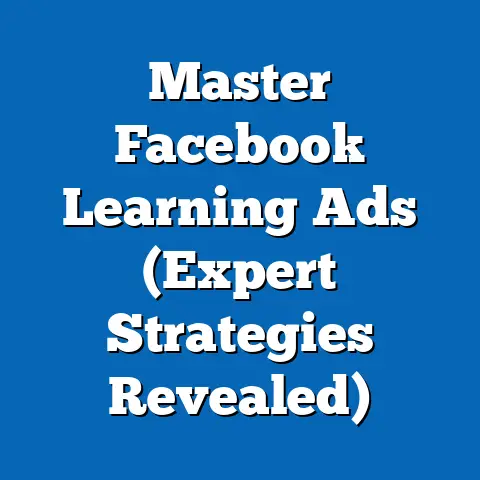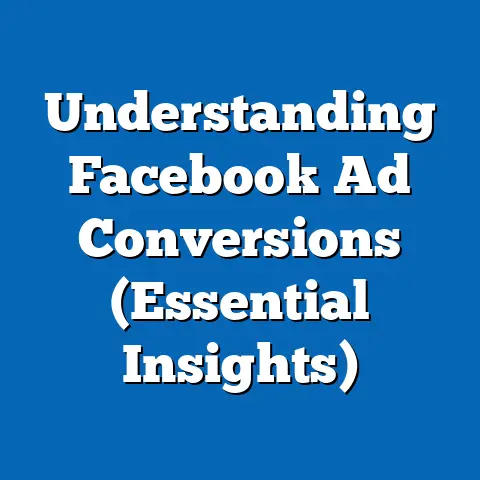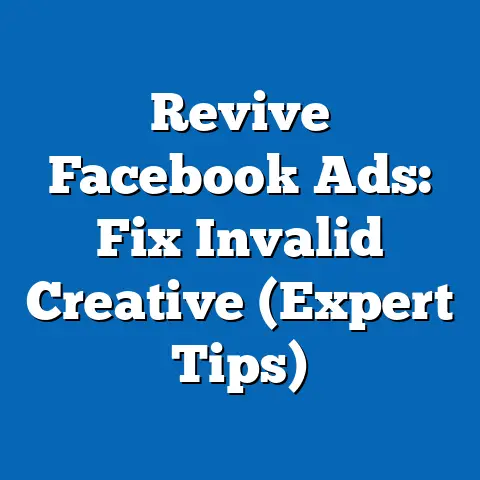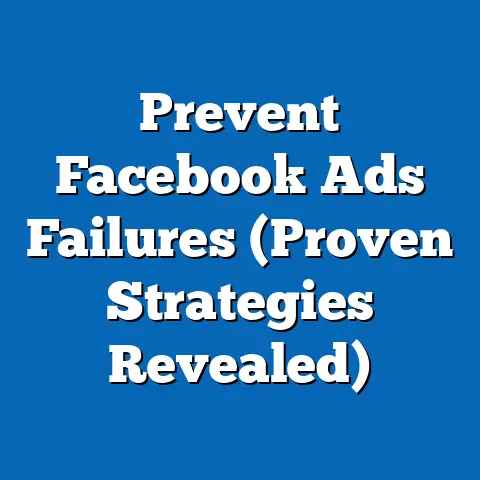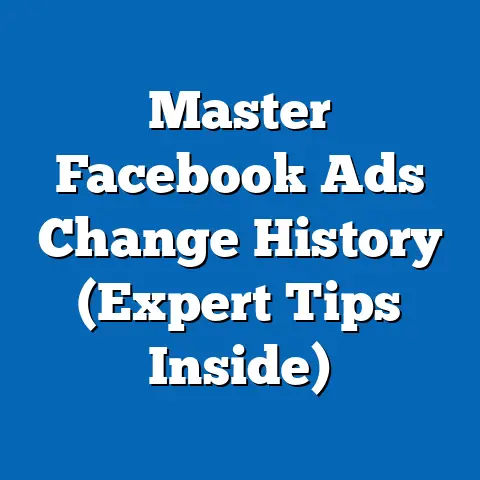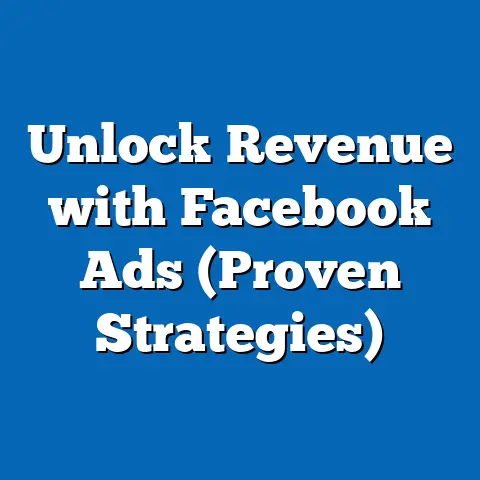Boost Engagement with Facebook Ad Blocker Strategies (Essential Tips)
The world is changing, and so is the way we consume information and interact with brands online. We’re seeing a massive wave of eco-consciousness sweeping across consumer markets. People are more aware than ever of the impact their choices have on the planet, and they’re demanding that brands step up and take responsibility. This isn’t just a trend; it’s a fundamental shift in values. As marketers, we can’t afford to ignore this.
Adding to this shift is the rise of ad blockers. Let’s face it, the internet can be overwhelming. A constant barrage of ads, pop-ups, and trackers can make the online experience frustrating and intrusive. Ad blockers have emerged as a popular solution, empowering users to take control of their digital environment. They represent a desire for a cleaner, more user-friendly, and, in some ways, more sustainable online experience.
So, what does this mean for us, the Facebook advertisers? It means we need to evolve. The old tactics of aggressive advertising and interruptive marketing are becoming less and less effective. We need to find new ways to reach our audience, ways that are both engaging and respectful of their choices.
This article is your guide to navigating this new landscape. I’ll share essential tips and strategies that will help you boost engagement on Facebook, even with ad blockers in place. I’ll show you how to embrace eco-conscious messaging, leverage Facebook’s native features, and measure your success in a way that truly reflects the value you’re creating. It’s time to move beyond simply pushing products and start building genuine connections with your audience.
Section 1: Understanding the Ad Blocker Landscape
Before diving into solutions, let’s get a clear picture of the problem. How widespread is ad blocker usage? Why are people using them? And what are the implications for your Facebook ad campaigns?
The Numbers Don’t Lie: Ad Blocker Usage is Significant
Ad blocker usage is more prevalent than many advertisers realize. While specific numbers fluctuate, the trend is clear: a significant portion of internet users are actively blocking ads.
- Growing Adoption: Studies consistently show a steady increase in ad blocker adoption over the years.
- Mobile is a Key Driver: Mobile ad blocking is on the rise, particularly in regions where data costs are high and users are more sensitive to bandwidth consumption.
- Younger Demographics Lead the Way: Younger generations, particularly Millennials and Gen Z, are more likely to use ad blockers than older demographics. This is crucial because these are often the target audiences for many Facebook advertisers.
What do these numbers mean for you? Simply put, a portion of your target audience isn’t seeing your ads. This impacts your reach, impressions, and potentially your conversion rates. It’s a challenge, but also an opportunity to rethink your approach.
Why the Block? Understanding the Motivations Behind Ad Blocker Adoption
People don’t just install ad blockers on a whim. There are several key motivations driving this trend:
- Privacy Concerns: This is a big one. Users are increasingly concerned about how their data is collected and used by advertisers. They want more control over their online privacy.
- Annoying Ads: Let’s be honest, some ads are just plain annoying. Pop-ups, auto-playing videos, and intrusive banners can ruin the online experience.
- Slow Load Times: Ads can significantly slow down page load times, especially on mobile devices. This is a major frustration for users, leading them to seek out ad blockers to improve their browsing speed.
- Security Risks: Some ads can be malicious, leading to malware infections or phishing scams. Ad blockers offer a layer of protection against these threats.
- Data Consumption: Ads consume data, which can be a significant cost for users with limited data plans, especially in developing countries.
- Eco-Consciousness: While perhaps not the primary driver, there’s a growing awareness of the environmental impact of digital advertising. The constant loading of ads consumes energy and contributes to carbon emissions. Ad blockers can be seen as a small step towards a more sustainable digital experience.
Implications for Facebook Advertisers: A Call to Action
The rise of ad blockers presents a significant challenge for Facebook advertisers. It means:
- Reduced Reach: Your ads aren’t reaching everyone you intend them to.
- Lower ROI: Your ad spend may be less effective if a portion of your target audience isn’t seeing your ads.
- Increased Competition: As the pool of users who do see ads shrinks, competition for their attention increases.
- Need for Innovation: You need to find new and creative ways to reach your audience, ways that go beyond traditional advertising.
Takeaway: Understanding the ad blocker landscape is the first step towards developing effective strategies. Recognize the motivations behind ad blocker adoption and acknowledge the impact on your campaigns. This understanding will inform your approach and guide you towards more sustainable and engaging marketing practices.
Next Step: Research the ad blocker usage rates within your specific target audience. Use Facebook’s Audience Insights tool to get a better understanding of their online behavior and preferences.
Section 2: Strategies for Engaging Users with Ad Blockers
Now that we understand the challenges, let’s explore some effective strategies for engaging users who use ad blockers. These strategies focus on providing value, building relationships, and creating a more positive user experience.
Content Marketing: The King (and Queen) of Engagement
Content marketing is the cornerstone of any successful strategy in the age of ad blockers. Instead of interrupting users with ads, you’re providing them with valuable, informative, and entertaining content that they want to consume.
- Focus on Value: Create content that solves problems, answers questions, or provides insights that your audience finds useful.
- Know Your Audience: Understand their interests, needs, and pain points. Tailor your content to resonate with them.
- Variety is Key: Experiment with different content formats, such as blog posts, videos, infographics, podcasts, and case studies.
- Optimize for Search: Make sure your content is easily discoverable through search engines. Use relevant keywords and optimize your titles and descriptions.
- Promote Strategically: Share your content on Facebook and other social media platforms. Use targeted posts to reach specific segments of your audience.
Example: Let’s say you’re selling eco-friendly cleaning products. Instead of running ads that simply promote your products, you could create a blog post titled “10 Natural Cleaning Hacks for a Sparkling Home.” This provides value to your audience, positions you as an expert, and subtly introduces your products as a solution.
Native Advertising: Blending In, Standing Out
Native advertising is a form of advertising that blends seamlessly with the user experience. It looks and feels like organic content, making it less likely to be blocked or ignored.
- Context is Crucial: Native ads should be relevant to the content surrounding them. They should provide value and fit naturally within the user’s browsing experience.
- Transparency is Essential: Be upfront about the fact that it’s an ad. Use clear labeling, such as “Sponsored” or “Promoted.”
- Focus on Storytelling: Tell a compelling story that engages the user and highlights the benefits of your product or service.
- High-Quality Visuals: Use visually appealing images and videos that capture attention and communicate your message effectively.
Example: A clothing brand might partner with a popular fashion blogger to create a sponsored post showcasing their latest collection of sustainable clothing. The post would look and feel like a typical blog post from the blogger, but it would clearly disclose that it’s sponsored content.
Interactive Content: Engaging Users, Not Interrupting Them
Interactive content is a powerful way to engage users without being intrusive. It encourages participation and creates a more memorable experience.
- Polls and Quizzes: These are simple and effective ways to get users involved. Ask questions related to your brand or industry.
- Contests and Giveaways: Offer prizes or incentives to encourage participation.
- Interactive Videos: Create videos that allow users to make choices or explore different scenarios.
- 360° Photos and Videos: Immerse users in a virtual experience.
- Augmented Reality (AR) Filters: Let users try on your products virtually or create fun and engaging content.
Example: A travel company might create a quiz titled “What’s Your Ideal Eco-Friendly Vacation Destination?” The quiz would ask users questions about their travel preferences and then recommend a specific destination based on their answers.
Community Engagement: Building Relationships, Not Just Selling Products
Building a strong community around your brand is essential for long-term success. It fosters loyalty, encourages word-of-mouth marketing, and provides a valuable source of feedback.
- Create a Facebook Group: This provides a dedicated space for your audience to connect with each other and with your brand.
- Encourage Dialogue: Ask questions, start discussions, and respond to comments.
- Share Exclusive Content: Offer exclusive content, such as behind-the-scenes videos or early access to new products, to reward your community members.
- Host Events: Organize online or offline events to bring your community together.
- Listen to Your Audience: Pay attention to what your community members are saying. Use their feedback to improve your products, services, and marketing strategies.
Example: A sustainable living brand might create a Facebook group called “Eco-Conscious Living Tips & Tricks.” The group would be a place for members to share tips, ask questions, and support each other in their journey towards a more sustainable lifestyle.
Takeaway: Engaging users with ad blockers requires a shift in mindset. Focus on providing value, building relationships, and creating a positive user experience. Content marketing, native advertising, interactive content, and community engagement are all powerful tools in your arsenal.
Next Step: Brainstorm content ideas that align with your brand and your target audience’s interests. Create a content calendar and start planning your content strategy.
Section 3: Leveraging Eco-Conscious Messaging
In today’s world, consumers are increasingly drawn to brands that demonstrate a genuine commitment to sustainability and social responsibility. Eco-conscious messaging isn’t just a feel-good trend; it’s a powerful way to connect with your audience, build trust, and drive engagement, especially in a landscape where ad blockers are prevalent.
The Power of Authenticity: Walking the Talk
The first and most important rule of eco-conscious messaging is to be authentic. Consumers are savvy and can easily spot greenwashing or insincere attempts to capitalize on the eco-trend.
- Be Transparent: Share your company’s sustainability initiatives and goals. Be open about your challenges and progress.
- Focus on Impact: Highlight the positive impact your products or services have on the environment. Quantify your impact whenever possible.
- Get Certified: Obtain certifications from reputable organizations to demonstrate your commitment to sustainability.
- Partner with Eco-Friendly Organizations: Collaborate with non-profits or other organizations that are working to protect the environment.
- Practice What You Preach: Make sure your company’s internal practices align with your external messaging.
Example: Patagonia is a brand that has built its reputation on authenticity and a deep commitment to environmental activism. They’re transparent about their supply chain, they donate a portion of their sales to environmental causes, and they actively campaign for environmental protection.
Elements of Effective Eco-Conscious Messaging
When crafting your eco-conscious messaging, keep these key elements in mind:
- Sustainability: Highlight the sustainable aspects of your products or services, such as recycled materials, renewable energy, or reduced packaging.
- Social Responsibility: Showcase your company’s commitment to ethical labor practices, community involvement, and social justice.
- Transparency: Be open and honest about your company’s practices and impact.
- Call to Action: Encourage your audience to take action, such as reducing their carbon footprint, supporting sustainable businesses, or advocating for environmental policies.
- Positive Tone: Focus on the positive aspects of sustainability and the benefits of making eco-conscious choices.
Example: A coffee company might highlight the fact that their coffee beans are ethically sourced from sustainable farms, their packaging is made from recycled materials, and they donate a portion of their profits to support coffee-growing communities.
Show, Don’t Just Tell: Using Visuals to Convey Your Message
Visuals are a powerful way to communicate your eco-conscious message. Use images and videos that showcase your sustainability initiatives, your eco-friendly products, or the positive impact you’re having on the environment.
- Showcase Sustainable Practices: Share photos or videos of your factory using renewable energy, your employees volunteering in the community, or your products being made from recycled materials.
- Highlight Eco-Friendly Features: Use close-up shots to showcase the eco-friendly features of your products, such as recycled packaging or organic ingredients.
- Tell a Story: Create a video that tells the story of your company’s commitment to sustainability.
- Use Infographics: Use infographics to visually communicate complex data about your environmental impact.
Example: A skincare brand might create a video showcasing their sustainable farming practices, highlighting the organic ingredients they use and the positive impact they’re having on the local ecosystem.
Examples of Brands Doing It Right
Here are a few examples of brands that have successfully integrated eco-conscious principles into their Facebook ad strategies:
- Allbirds: This shoe company is known for its sustainable materials and transparent supply chain. Their Facebook ads often highlight the eco-friendly aspects of their shoes and their commitment to reducing their carbon footprint.
- Seventh Generation: This cleaning product company is committed to using plant-based ingredients and sustainable packaging. Their Facebook ads often focus on the health and environmental benefits of their products.
- Beyond Meat: This plant-based meat company is on a mission to create a more sustainable food system. Their Facebook ads often highlight the environmental benefits of eating plant-based meat.
Takeaway: Eco-conscious messaging is a powerful way to connect with your audience, build trust, and drive engagement, especially in a landscape where ad blockers are prevalent. Be authentic, focus on impact, and use visuals to communicate your message effectively.
Next Step: Review your current messaging and identify opportunities to incorporate eco-conscious themes. Research your audience’s values and tailor your messaging to resonate with them.
Section 4: Utilizing Facebook Features Beyond Ads
While paid advertising is a core component of most Facebook marketing strategies, it’s important to remember that Facebook offers a wealth of features that can be leveraged to engage users organically, especially those who are using ad blockers.
Facebook Live: Real-Time Engagement, Authentic Connections
Facebook Live allows you to broadcast live video to your audience. This is a powerful way to create real-time engagement, build authentic connections, and foster a sense of community.
- Behind-the-Scenes: Give your audience a glimpse behind the scenes of your company. Show them how your products are made, introduce them to your team, or take them on a tour of your office.
- Q&A Sessions: Host a Q&A session with your audience. Answer their questions about your products, services, or industry.
- Product Demos: Demonstrate how your products work. Highlight their features and benefits.
- Interviews: Interview industry experts or influencers.
- Events: Broadcast live events, such as conferences, concerts, or festivals.
Example: A local bakery might use Facebook Live to broadcast a baking demonstration, showing their audience how to make their signature sourdough bread.
Stories and Reels: Short-Form Content, Big Impact
Facebook Stories and Reels are short-form video formats that are incredibly popular, especially among younger audiences. They’re a great way to capture attention, share quick updates, and drive engagement.
- Quick Updates: Share quick updates about your company, products, or promotions.
- Behind-the-Scenes: Give your audience a glimpse behind the scenes of your company.
- User-Generated Content: Share user-generated content, such as photos or videos of customers using your products.
- Interactive Stickers: Use interactive stickers, such as polls, quizzes, and question boxes, to engage your audience.
- Creative Filters: Use creative filters to add a fun and engaging element to your content.
Example: A clothing brand might use Facebook Stories to showcase their latest collection, highlighting the different styles and colors available.
User-Generated Content: Leveraging the Power of Your Audience
User-generated content (UGC) is content created by your audience, such as photos, videos, or reviews. It’s a powerful way to build trust, enhance authenticity, and drive engagement.
- Run a Contest: Encourage your audience to submit their own content for a chance to win a prize.
- Ask for Reviews: Encourage your customers to leave reviews on your Facebook page.
- Share Customer Photos: Share photos of customers using your products on your Facebook page.
- Create a Hashtag: Create a branded hashtag and encourage your audience to use it when sharing content related to your brand.
- Feature Your Fans: Feature your fans on your Facebook page.
Example: A restaurant might run a contest asking customers to submit photos of their favorite dishes. The winning photo would be featured on the restaurant’s Facebook page.
Takeaway: Don’t rely solely on paid advertising to reach your audience. Leverage Facebook’s native features, such as Facebook Live, Stories, Reels, and user-generated content, to engage users organically and build authentic connections.
Next Step: Experiment with different Facebook features and see what works best for your brand. Track your results and adjust your strategy accordingly.
Section 5: Analyzing Engagement Metrics
In a world where ad blockers are increasingly common, relying solely on traditional advertising metrics like impressions and click-through rates can be misleading. To truly understand the effectiveness of your Facebook marketing efforts, you need to focus on engagement metrics that reflect the quality of your interactions with your audience.
Beyond Impressions: Focusing on Meaningful Interactions
While impressions (the number of times your content is displayed) are still a useful metric, they don’t tell the whole story. You need to dig deeper and focus on metrics that indicate genuine engagement, such as:
- Organic Reach: The number of unique users who saw your content without you paying for distribution. This is a key indicator of the value and relevance of your content.
- Engagement Rate: The percentage of users who interacted with your content (likes, comments, shares, clicks). This metric provides a comprehensive view of how engaging your content is.
- Comments: The number of comments on your posts. Comments indicate that users are actively engaging with your content and are interested in what you have to say.
- Shares: The number of times your content is shared. Shares indicate that users find your content valuable and are willing to recommend it to their friends.
- Video Views: The number of times your videos are viewed. This is a key metric for video content.
- Time Spent: The amount of time users spend watching your videos or reading your content. This indicates how engaging and informative your content is.
- Website Traffic: The amount of traffic your Facebook content drives to your website. This is a key indicator of the effectiveness of your Facebook marketing efforts in driving business results.
Facebook Analytics: Your Data-Driven Compass
Facebook provides a wealth of analytics that can help you track your engagement metrics and understand how your content is performing.
- Facebook Insights: This is the primary analytics tool for Facebook pages. It provides detailed data on your audience, your content performance, and your overall engagement.
- Facebook Business Suite: This tool provides a unified view of your Facebook and Instagram accounts, allowing you to track your performance across both platforms.
- Facebook Ads Manager: This tool provides detailed data on your paid advertising campaigns, including impressions, click-through rates, and conversion rates.
Tracking User Sentiment: Understanding the Emotional Connection
Beyond quantitative metrics, it’s also important to understand the sentiment surrounding your brand and your content. Are people responding positively or negatively? Are they engaged and excited, or are they indifferent or even hostile?
- Monitor Comments: Pay close attention to the comments on your posts. Are people expressing positive or negative sentiments?
- Read Reviews: Read the reviews on your Facebook page. What are people saying about your products or services?
- Use Sentiment Analysis Tools: There are several tools available that can automatically analyze the sentiment of text, such as comments and reviews.
Takeaway: In a landscape where ad blockers are prevalent, it’s essential to focus on engagement metrics that reflect the quality of your interactions with your audience. Use Facebook Analytics to track your metrics, understand your audience, and optimize your content strategy.
Next Step: Review your current metrics and identify areas for improvement. Set goals for your engagement metrics and track your progress over time.
Conclusion
The world of Facebook advertising is constantly evolving. The rise of eco-consciousness and the increasing use of ad blockers are just two of the many challenges and opportunities that marketers face today.
To succeed in this new landscape, we need to shift our focus from intrusive advertising to more meaningful and engaging strategies. We need to provide value, build relationships, and create a positive user experience. We need to embrace eco-conscious messaging and leverage Facebook’s native features to connect with our audience on a deeper level.
By implementing the essential tips outlined in this article, you can boost engagement, build trust, and drive business results, even in a world where ad blockers are prevalent. It’s time to move beyond simply pushing products and start building genuine connections with your audience.
Call to Action: Implement these essential tips to boost engagement while respecting user preferences and promoting a more sustainable online experience. Start experimenting with different strategies, track your results, and adjust your approach accordingly. The future of Facebook advertising is about building relationships, not just pushing ads.

